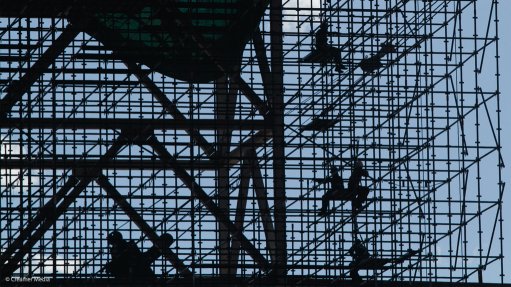
The Medupi project
Photo by: Duane Daws
State-owned electricity producer Eskom plans to announce the completion date of Medupi Unit 5 – the second 794 MW unit at the Limpopo power project – by the latest March next year, having indicated that the original commissioning interval of six months following the introduction of the first unit, Unit 6, was no longer possible.
However, the utility could not be drawn directly on commentary by University of Cape Town Graduate School of Business Professor Anton Eberhard suggesting that there would be a two-and-a-half-year gap between the first two units.
Writing in Business Day, Eberhard, who is also a member of the National Planning Commission said: “What has not been made public, but has been admitted privately by senior Eskom managers, is that the second Medupi unit — originally due six months after the first — will be commissioned only two-and-a-half-years later. Kusile’s first unit is due to come online only in 2016, then there is the long, difficult task of commissioning the remaining units. Full power may be available only in 2020.”
In response to Engineering News Online questions on the expected interval, Eskom indicated that it had “committed publicly to have Medupi power station fully commissioned by 2019” ¬ – the six-unit coal-fired power station will have an ultimate nameplate capacity of 4 764 MW.
“The first unit of Medupi (Unit 6) will be synchronised in December 2014 with full power to the grid six months later. We have also indicated that the commissioning of the next unit (Unit 5) within six months of bringing Unit 6 on line, as initially forecasted, was no longer possible due to challenges of quality and productivity that we experienced on Unit 6.”
Eskom said it expected to be in a position to announce the completion date of Unit 5, as well as the rest of the units, by March, adding that the schedule should “taper towards a shorter interval for later units as we optimise on earlier challenges and gather maximum momentum”.
Eberhard told Engineering News Online that his information was based on a detailed quarter-by-quarter plan for each of the units at Medupi and Kusile given to him by “a very senior Eskom manager”.
The focus currently, Eskom said, was on the completion of Unit 6, as this represented “a big milestone in South Africa’s capacity expansion programme”. The overall programme was designed to add 17 400 MW of additional capacity by 2019, with 6 134 MW already commissioned.
“We are engaging our contractors on a continuous basis on improving productivity and they have responded positively by deploying senior managers in construction and engineering to beef up the current teams. The lessons learnt at Medupi and improved execution models are applied at Kusile power station too.”
Eskom again stressed that its warning of five more years of power shortages was a “worst-case scenario” which would depend on a variety of issues.
“These include assumptions made on growth in electricity demand, independent power producers bringing generation capacity on line, progress at Medupi and Kusile and the performance of our existing power station. We are doing a lot of work to improve availability of our generating units.”
In 2013/14, the group’s unplanned capacity loss factor, or UCLF, rose to around 11%, while its energy availability factor fell to 75.1%. Eskom was forecasting plant availability of 75.5% for the remainder of the 2014/15 financial year.
It had also revealed that 32 of its 87 coal-fired generating units required “major surgery”, while four were in a “critical condition”.
In the same article, Eberhard called on President Jacob Zuma to appoint a commission of inquiry into South Africa’s worst electricity crisis in 40 years and to offer policy proposals for reforming Eskom and the sector.
He argued that there was an historical precedent for such an inquiry in the form of the 1983 De Villiers Commission, adding that the resulting recommendations led to “profound changes in Eskom’s organisational culture and efficiency”.
“A new commission of inquiry will help us understand what has gone wrong. It can build on the restructuring proposals in the 1998 energy policy white paper, which were never implemented, and will provide the basis for opening the sector to investors and operators that can help restore electricity supply security and economic growth.”